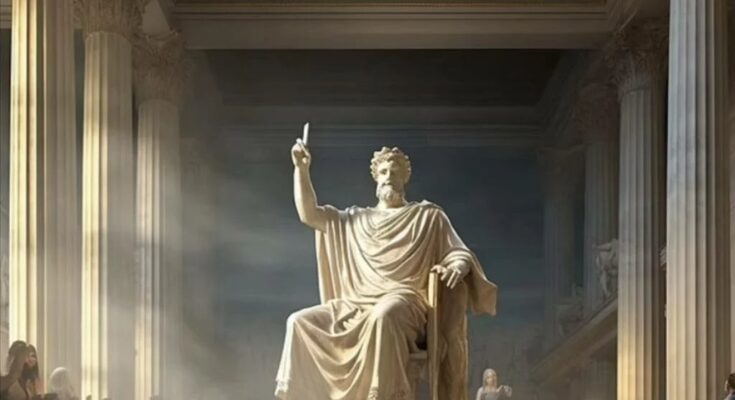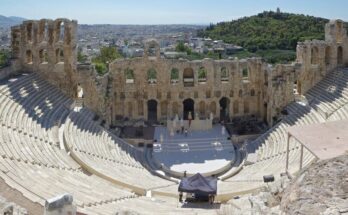Artificial intelligence (AI) has the potential to bring the ancient Seven Wonders of the World, such as the Colossus of Rhodes and the Hanging Gardens of Babylon, back to life.
AI, using the Midjourney image generator, has successfully recreated these historic marvels in today’s virtual world.
Except for the Great Pyramid of Giza, various factors such as wars, the decline of civilizations, and natural disasters have led to the loss of these structures over time.
Seven Wonders of the Ancient World according to AI
Great Pyramid of Giza

The AI images also feature the Great Pyramid of Giza, a wonder that still captivates tourists to this day. Built in the early 26th century BC, it took twenty-seven years to complete. Ancient Egyptians, under the command of Pharaoh Khufu, hauled stones weighing up to two and a half tons each.
As time passed, much of the smooth, white limestone casing was removed, reducing the pyramid’s height from 146.6 meters to 138.5. AI has restored its iconic white limestone casing at the top, restoring its original appearance.
The Statue of Zeus at Olympia

A colossal forty-foot-tall gold and ivory statue of Zeus once graced a temple in Olympia, Greece. It was crafted to compete with those in Athens. The eleventh-century Byzantine historian Georgios Kedrenos noted that the statue was carried off to Constantinople, where it was destroyed in the great fire of the Palace of Lausus in 475 AD.
The Colossus of Rhodes

The renowned one hundred-foot statue, portraying the Greek sun god Helios, was an impressive engineering marvel that graced the harbor of the Greek island of Rhodes.
A significant moment in its history occurred in 226 BC, when an earthquake struck, causing the colossal statue to collapse at its knees after having stood proudly for fifty-four years.
Contrary to ancient artwork depicting the statue straddling the harbor entrance, researchers now believe it stood on a pedestal near the entrance, welcoming visiting ships.
The AI-generated image aligns with this insight, showcasing the Colossus in its accurate location and also including people to provide a glimpse of how it might appear in the present day.
The Temple of Artemis at Ephesus

Dedicated to Artemis, the Greek goddess of chastity, hunting, wild animals, forests, and fertility, this wonder experienced a turbulent history, being constructed and demolished three times.
First, it fell victim to Herostratus, seeking fame. Then, the Goths, fleeing from the Romans, wrecked it while passing through. Its final demise occurred in 401 AD when a Christian mob tore it down, leaving only foundations and a solitary column still visible today.
The Lighthouse of Alexandria

Long ago, the most famous lighthouse stood tall at about three hundred and fifty feet on Pharos island in the Alexandria harbor of ancient Egypt.
Constructed during the rule of Ptolemy II Philadelphus (280-247 BC), it was a sophisticated structure crafted to showcase the intellectual achievements of the world, revealing its mathematical and geometric foundations.
Sostratus of Cnidus was the mastermind behind the design, featuring a burning fire atop a cylindrical tower, an octagonal middle, and a square base.
However, the lighthouse gradually fell into disrepair following three earthquakes between 965 and 1323 AD.
The Mausoleum at Halicarnassus

Built in 350 BC as a tomb for Mausolus, the ruler of Caria in ancient Asia Minor, this structure was so remarkable that it gave rise to the term “mausoleum,” now commonly used for significant funeral monuments.
The structure combined design elements from Greek, Near Eastern, and Egyptian traditions, using Anatolian and Pentelic marble.
However, the mausoleum met its end due to a series of earthquakes between the twelfth and fifteenth centuries. It was the last of the six ancient wonders to succumb to destruction.
The Hanging Gardens of Babylon

The Hanging Gardens of Babylon said to feature intricate terraces, stunning water elements, and floating plants, are believed to have existed around 600 BC. Legend has it that they were situated roughly fifty miles south of present-day Baghdad in Iraq.
However, historical records of the gardens are solely found in ancient tales. One story holds that Babylonian Emperor Nebuchadnezzar built the gardens for his wife, Amyitis. Surprisingly, there’s no mention of the gardens in any texts written by the Emperor or his wife.
If these gardens did indeed exist, they would have met their end when the Achaemenid Empire conquered Babylon in 539 BC.



